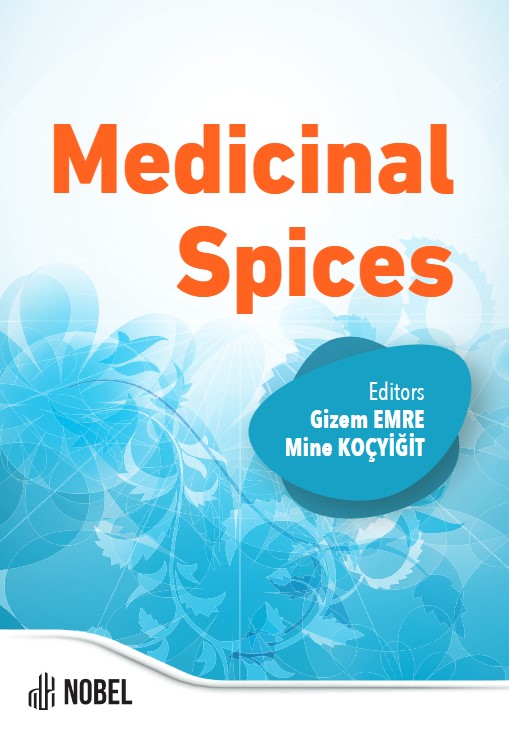Cinnamomum Verum J. S. Presl.
Mehmet Zeki Haznedaroglu (Author)
Release Date: 2024-06-10
Cinnamomum verum is also known as the cinnamon tree and grows primarily in the tropical climates of Southeast Asia. This tree has thick, glossy leaves and fragrant flowers that stay green throughout the year. But the most striking part is its bark. Its bark is the main source of the cinnamon spice. Once harvested, the [...]
Media Type
Buy from
Price may vary by retailers
| Work Type | Book Chapter |
|---|---|
| Published in | Medicinal Spices |
| First Page | 1 |
| Last Page | 14 |
| DOI | https://doi.org/10.69860/nobel.9786053359340.1 |
| Page Count | 14 |
| Copyright Holder | Nobel Tıp Kitabevleri |
| License | https://nobelpub.com/publish-with-us/copyright-and-licensing |
Mehmet Zeki Haznedaroglu (Author)
Professor, Izmir Katip Celebi University
https://orcid.org/0000-0002-5569-7891
3M. Zeki Haznedaroğlu completed his doctorate in 2004 at Ege University. Currently He is working as a professor in İzmir Katip Celebi University, Faculty of Pharmacy, Department of Pharmaceutical Botany. His areas of expertise are medicinal plants, marine phanerogam plants, phytochemical studies and ethnobotanical studies.
https://wfoplantlist.org/taxon/wfo-4000008342-2023-12?page=1 (Access Date: 25.05.2024).
https://www.cbi.eu/market-information/spices-herbs/cinnamon-market-potential (Access Date: 29.05.2024).
Committee on Herbal Medicinal Products (HMPC), Assessment report on Cinnamomum verum J. S. Presl, cortex and corticis aetheroleum EMA/HMPC/246773/2009, 10 May 2011.
https://apps.worldagroforestry.org/treedb/AFTPDFS/Cinnamomum_verum.PDF (Access Date: 25.05.2024).
Vallianou N, Tsang C, Taghizadeh M, Davoodvandi A, and Jafarnejad S. Effect of cinnamon (Cinnamomum Zeylanicum) supplementation on serum Creactive protein concentrations: A meta-analysis and systematic review. Complementary Therapies in Medicine. 2019; 42: 271–278.
Council Of Europe, European Pharmacopoeia, Ninth Edition Volume I. Cinnamon, Cinnamomi Cortex. Strasbourg, 2016; 04/2011:0387, 1317.
https://powo.science.kew.org/taxon/urn:lsid:ipni.org:names:463752-1/general-information (Access Date: 25.05.2024).
Singh N, Singh Rao A, Nandal A, Kumar S, Singh Yadav S, Ahmad Ganaie S, Narasimhan B. Phytochemical and pharmacological review of Cinnamomum verum J. Presl-a versatile spice used in food and nutrition. Food Chemistry 2021; 338 127773.
Oketch-Rabah H A, Marles R J, Brinckmann J A. Cinnamon and Cassia Nomenclature Confusion: A Challenge to the Applicability of Clinical Data. Clinical Pharmacology & Therapeutics. 2018; 104, 33, 435 – 445.
Karadag A E, Biltekin S N, Ghani U, Demirci B, Demirci F. Enzyme-Based Antiviral Potential of Cinnamomum verum J. Presl. Essential Oil and Its Major Component (E)-Cinnamaldehyde. ACS Omega. 2024; 9(12):14118-14122.
Williams A R, Ramsay A, Hansen T V A, ⦁ 1, Ropiak H M, Mejer H, Nejsum P, Mueller-Harvey I, Thamsborg S M. Anthelmintic activity of trans-cinnamaldehyde and A- and B-type proanthocyanidins derived from cinnamon (Cinnamomum verum). Sci Rep. 2015; 30:5:14791.
Varadarajan S, Narasimhan M, Balaji T M, Chamundeeswari D P, Sakthisekaran D.J. In Vitro Anticancer Effects of Cinnamomum verum J. Presl, Cinnamaldehyde, 4 Hydroxycinnamic Acid and Eugenol on an Oral Squamous Cell Carcinoma Cell Line. Contemp Dent Pract. 2020; 21(9):1027-1033.
Bellassoued K, Ghrab F, Hamed H, Kallel R, van Pelt J, Lahyani A, Ayadi F M, El Feki A. Protective effect of essential oil of Cinnamomum verum bark on hepatic and renal toxicity induced by carbon tetrachloride in rats. Appl Physiol Nutr Metab. 2019; 44(6):606-618.
Santos H O, da Silva G A R. To what extent does cinnamon administration improve the glycemic and lipid profiles? Clinical Nutrition ESPEN 27 (2018) 1 – 9.
Leach_M J, Kumar_S. Cinnamon for diabetes mellitus. Cochrane Database of Systematic Reviews 2012; 9. Art. No.: CD007170.
Pattanittum_P, Kunyanone_N, Brown_J, Sangkomkamhang_US, Barnes_J, Seyfoddin_V, Marjoribanks_J. Dietary supplements for dysmenorrhoea. Cochrane Database of Systematic Reviews 2016; 3. Art. No.: CD002124.
Jazani A M, Azgomi H N D, Azgomi A N D, Azgomi R N D. A comprehensive review of clinical studies with herbal medicine on polycystic ovary syndrome (PCOS) DARU Journal of Pharmaceutical Sciences. 2019; 27:863–877.
Panahishokouh M, Noroozian M, Mohammadian F, Khanavi M, Mirimoghaddam M, Savar SM, Nikoosokhan M, Honarmand H, Mohebbi N. Evaluation of the Effectiveness of an Herbal Formulation of Boswellia sacra Flueck. In Improving Cognitive and Behavioral Symptoms in Patients with Cognitive Impairment and Alzheimer's Disease. J Res Pharm Pract. 2023; 24;11(3):91-98.
Krittanawong C, Isath A, Scott CZ, Wang Z, Kaplin S, Jneid H, Lavie CJ, Virani SS. Association Between Cinnamon Consumption and Risk of Cardiovascular Health: A Systematic Review and Meta-Analysis. Am J Med. 2022;135(1):110-117.
Use of Cinnamomum Verum for Induction of Labor. Double Blind Randomized Clinical Trial. NCT06164613; https://clinicaltrials.gov/ct2/show/NCT06164613, 2023 added to Central: 31 December 2023 | 2023 Issue 12
Lonati E, Sala G, Corbetta P, Pagliari S, Cazzaniga E, Botto L, Rovellini P, Bruni I, Palestini P, Bulbarelli A. Digested Cinnamon (Cinnamomum verum J. Presl) Bark Extract Modulates Claudin-2 Gene Expression and Protein Levels under TNFα/IL-1β Inflammatory Stimulus. Int J Mol Sci. 2023;24(11):9201.
| onix_3.0::thoth | Thoth ONIX 3.0 |
|---|---|
| onix_3.0::project_muse | Project MUSE ONIX 3.0 |
| onix_3.0::oapen | OAPEN ONIX 3.0 |
| onix_3.0::jstor | JSTOR ONIX 3.0 |
| onix_3.0::google_books | Google Books ONIX 3.0 |
| onix_3.0::overdrive | OverDrive ONIX 3.0 |
| onix_2.1::ebsco_host | EBSCO Host ONIX 2.1 |
| csv::thoth | Thoth CSV |
| json::thoth | Thoth JSON |
| kbart::oclc | OCLC KBART |
| bibtex::thoth | Thoth BibTeX |
| doideposit::crossref | CrossRef DOI deposit |
| onix_2.1::proquest_ebrary | ProQuest Ebrary ONIX 2.1 |
| marc21record::thoth | Thoth MARC 21 Record |
| marc21markup::thoth | Thoth MARC 21 Markup |
| marc21xml::thoth | Thoth MARC 21 XML |

